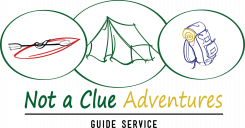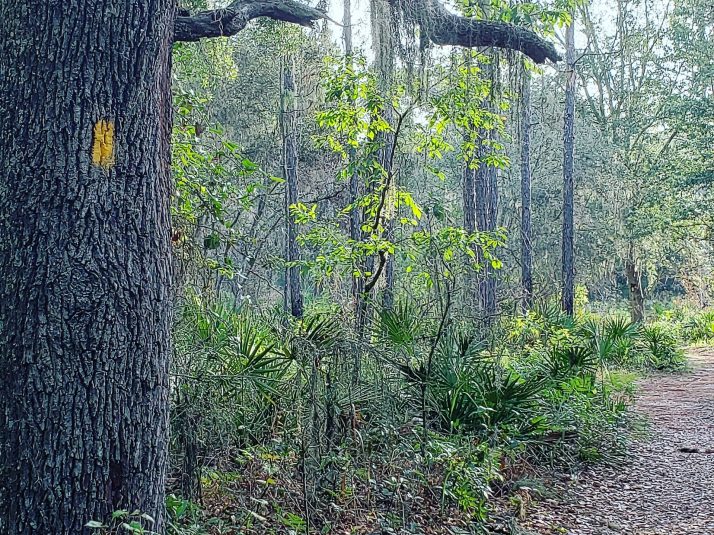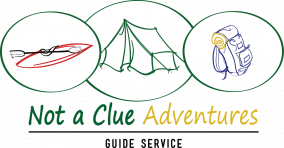In this post we want to cover how to take a hike. For most people the first step into a life full of outdoor activities is a day-hike. Exploring in the outdoors can easily become a lifelong passion; it starts with putting one foot in front of the other.
The difference between a hike and a walk
We get asked this question often by folks are “concerned” if they can “make it” when they schedule a Guided Day Hike or Walking Eco Tour with Not a Clue Adventures. Many folks don’t realize they walk over 5 miles a day just in their day to day life (approximately 10,000 steps equals 4-5 miles)
The simple answer is when you are taking a walk you are taking steps of consistent distance and moving at a mostly regular pace. Oftentimes your walks are not interrupted and there is a rhythm to your motion and your distance is pre-planned. Most persons take walks while shopping in the mall, at the beach, or around the neighborhood often accompanied by friends, pets and children. When hiking the motion of your movement will change often. Walking is typically a casual activity, typically done in an urban area on a solid surface such at a well worn path or sidewalk.
When hiking your distance between steps will vary based on the terrain. You may have to pay more attention where you foot is going next if path is rocky or muddy. There will be things that attract your attention causing you to divert from the planed destination to learn more or see something closer. There may be a cross trail you decide to explore or you may stop to watch a family of deer grazing in a meadow that will change you planned hike either in distance or in time planned to finish. Hiking is typically done in rural areas or places where you are able to immerse yourself in the surroundings. The trails are not always smooth and even and often there are elevation changes.
Hiking is great exercise
When taking a walk you will burn approximately 500 calories (based on a 180lb person). When hiking you will often burn more calories due to the uneven or challenging terrain and also if you are carrying extra weight, like a daypack with first aid kit, water, lunch, snacks and emergency items. You body will you’re your muscles differently in your feet and legs and torso as you have to balance and shift your stance on more challenging terrain. Hiking is also great for your mental health and for relieving stress. Your senses will pick up the winds and smells of the area, your blood pressure will start to drop and you begin to relax, you may breathe deeper as you taking in the smell of wildflowers or exert extra energy refreshing your lungs. You will also gain self confidence and self-esteem the more you hike, reaching new goals and destinations.
Where to go to take a hike
Once you have determined you are ready to take a hike and you are comfortable walking certain distances you will need a place to go. There is a wonderful mixture of hiking locations that can be found anywhere you go! From County Parks, State Parks, National Wildlife Refuges, Wildlife Management Districts and state and national forests. Out west there are BLM lands (Bureau of Land Management properties as well) Click here for a FREE download of resources you can print
What to wear when you take a hike
When you take your hike, you will want to consider protection from sun, heat, water and even poisonous plants that may grow along the trail. Consider top to bottom items such as:
Hat, sunglasses, visor
Bandana, buff, scarf
Moisture wicking light weight short or long sleeve shirt –quick dry layers for the summer and heavier weight clothing for the winter - avoid cotton.
Light weight, rip-stop or fast drying convertible hiking pants in summer or khakis in winter
Quality socks – preferably a wool blend that will pull moisture away from your feet. We prefer Darn Tough – and they have a lifetime warranty!
Hiking boots, closed toe shoes. I know many people that enjoy hiking in trail runners or hiking sandals as well. You need to make sure, whatever shoe you choose to hike in; the shoes are well fitted and made for the trail.
Safety while hiking
Everyone’s personal safety needs are different and you should take some time to think about the things you will need to have with you when you take your hike. Hydration, map, emergency contact information, location/on site manager emergency # are all good items to have with you. I highly suggest attending or viewing a Leave No Trace training that covers 7 outdoor principles that will inform you on how to enjoy the outdoors responsibly – and pay special attention to the plan and prepare principle.
What to bring on a day-hike
If you begin to hike frequently keep a day pack with these items ready to go at your door or in your car so you never miss an opportunity to take a hike!
Day Pack
ID and emergency contact # written on card in protected waterproof wallet
Environmentally safe sunscreen
Insect repellent
Map/compass/GPS (extra batteries)
Emergency Whistle
First aid kit – that addresses hiking needs – including Band-Aids, antiseptic cream, ace bandage, Benadryl, etc
Drinks – STAY HYDRATED!
Snacks (chocolate and yogurt coated items not wise in summer)
A way to make fire
Flashlight – ALWAYS
Bathroom kit (a small amount of toilet paper, hand sanitizer, and 2 Ziploc bags – 1 for everything in kit and one for used paper)
Extra Socks
Head net (for hiking in insect prone areas)
Other items that add to the fun are trail guides, binoculars, camera, survival items (such as cording, mirror, duct tape, fishing line/hook etc.)
In addition to above items you may want to consider purchasing a pair of hiking stick (great for your knees, balance and getting in some upper body work while hiking)
Check out our blog on preventing mosquito bites
We hope this information helps get you excited about hiking. If you are in Central Florida and are interested in booking a date to take a hike, we offer guided hikes in Florida so you don’t have to a hike alone. Reach out to Not a Clue Adventures – we can put something together for you!
See you on the trail!
Jeanene Fisher
Lead Guide and Owner
Not a Clue Adventures


